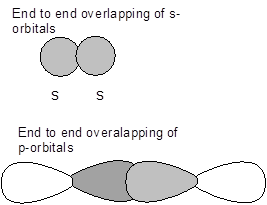
Explain how σ and
Interpretation:
The similarity and difference between s and p bonds is to be explained.
Concept Introduction:
- There are two types of bonds that are formed between the atoms-
- Electron in atoms occupy atomic orbitals while in molecule, electrons occupy molecular orbitals. These molecular orbitals are formed by the combination of the atomic orbitals and they can be bonding molecular orbitals and ant-bonding molecular orbitals.
- The process of mixing of atomic orbitals of similar energy to produce new molecular orbitals of equivalent energy is known as hybridization.
a) Covalent bond- the bond formed by the sharing of electrons between the atoms.
b) Ionic bond- When atoms gain/loss electrons and become ions, the electrostatic attraction between the oppositely charged ions is known as ionic bond.
Answer to Problem 1E
Similarity-They both are chemical covalent bonds and are formed by the overlapping of the atomic orbitals.
Differences-
| s- bond | ?-bond |
| Formed by the axial overlap of the atomic orbitals. | Formed by the side-ways overlap of the atomic orbitals. |
| It can be formed by the overlap of s-s, s-p or p-p orbitals. | It can only be formed by the overlap of p orbitals |
| Oriented along the internuclear axis. | Oriented perpendicular to the internuclear axis. |
| Exists independently. | Exist along with sigma bond. |
| Stronger than pi-bond. | Weaker than sigma bond. |
| More reactive. | Less reactive. |
| Determines the shape of the molecule. | Does not determine the shape of the molecule. |
Explanation of Solution
- Sigma (s) bonds- It is a type of covalent bond which is formed by the end to end overlapping of the atomic orbitals of the atoms involved in bonding.
- Pi (p)bonds -It is a type of covalent bond which is formed by the side wise overlapping of the atomic orbitals of the atoms involved in bonding.


Therefore, differences between sigma and pi bonds are-
| s- bond | ?-bond |
| Formed by the axial overlap of the atomic orbitals. | Formed by the side-ways overlap of the atomic orbitals. |
| It can be formed by the overlap of s-s, s-p or p-p orbitals. | It can only be formed by the overlap of p orbitals |
| Oriented along the internuclear axis. | Oriented perpendicular to the internuclear axis. |
| Exists independently. | Exist along with sigma bond. |
| Stronger than pi-bond. | Weaker than sigma bond. |
| More reactive. | Less reactive. |
| Determines the shape of the molecule. | Does not determine the shape of the molecule. |
However, the only similarity between these two are that they both are chemical covalent bonds and are formed by the overlapping the atomic orbitals, and the main difference is that sigma bond is formed by the axial overlap of the atomic orbitals, whereas, pi bond is formed by the sideways overlapping of atomic orbitals.
Want to see more full solutions like this?
Chapter 5 Solutions
Chemistry Atoms First2e
- In the molecular orbital mode l, compare and contrast bonds with bonds. What orbitals form the bonds and what orbitals form the bonds? Assume the z-axis is the internuclear axis.arrow_forwardConsidering only the molecular orbitals formed by combinations of the 2s atomic orbitals, how many molecular orbitals can be formed by 1000 Li atoms? In the lowest energy state, how many of these orbitals will be populated by pairs of electrons and how many will be empty?arrow_forwardTrue or false: Boron contains 2s22p1 valence electrons, so only one p orbital is needed to form molecular orbitals.arrow_forward
- Determine if the following species have permanent dipole moments. a Dichloromethane, CH2Cl2 b Chlorobenzene, C6H5Cl c Ammonia, NH3 d Carbon dioxide, CO2.arrow_forwardMolecular Orbital Theory (See Examples 9.49.6.) The hydrogen molecular ion, H2+, can be detected spectroscopically. Write the electron configuration of the ion in molecular orbital terms. What is the bond order of the ion? Is the hydrogenhydrogen bond stronger or weaker in H2+ than in H2s?arrow_forwardWhat type of molecular orbital would result from the in-phase combination of the two dxz atomic orbitals shown below? Assume the x-axis is the internuclear axis.arrow_forward
- Solid sulfur normally consists of crystals of S8 molecules, but when heated strongly, the solid vaporizes to give S2 molecules (among other molecular species). Describe the bonding in S2 in molecular orbital terms, assuming the orbitals are analogous to those of the preceding period. What would you expect to happen to the sulfur sulfur bond length if two electrons were added to give the S22 ion? What would you expect to happen to the bond length if, instead, two electrons were taken away to give S22+?arrow_forwardUse MO theory to predict the bond order and the number of unpaired electrons in the super-oxide ion, , and the peroxide ion, .arrow_forward
 Chemistry: The Molecular ScienceChemistryISBN:9781285199047Author:John W. Moore, Conrad L. StanitskiPublisher:Cengage Learning
Chemistry: The Molecular ScienceChemistryISBN:9781285199047Author:John W. Moore, Conrad L. StanitskiPublisher:Cengage Learning Chemistry: Principles and PracticeChemistryISBN:9780534420123Author:Daniel L. Reger, Scott R. Goode, David W. Ball, Edward MercerPublisher:Cengage Learning
Chemistry: Principles and PracticeChemistryISBN:9780534420123Author:Daniel L. Reger, Scott R. Goode, David W. Ball, Edward MercerPublisher:Cengage Learning General Chemistry - Standalone book (MindTap Cour...ChemistryISBN:9781305580343Author:Steven D. Gammon, Ebbing, Darrell Ebbing, Steven D., Darrell; Gammon, Darrell Ebbing; Steven D. Gammon, Darrell D.; Gammon, Ebbing; Steven D. Gammon; DarrellPublisher:Cengage Learning
General Chemistry - Standalone book (MindTap Cour...ChemistryISBN:9781305580343Author:Steven D. Gammon, Ebbing, Darrell Ebbing, Steven D., Darrell; Gammon, Darrell Ebbing; Steven D. Gammon, Darrell D.; Gammon, Ebbing; Steven D. Gammon; DarrellPublisher:Cengage Learning Chemistry & Chemical ReactivityChemistryISBN:9781133949640Author:John C. Kotz, Paul M. Treichel, John Townsend, David TreichelPublisher:Cengage Learning
Chemistry & Chemical ReactivityChemistryISBN:9781133949640Author:John C. Kotz, Paul M. Treichel, John Townsend, David TreichelPublisher:Cengage Learning Chemistry by OpenStax (2015-05-04)ChemistryISBN:9781938168390Author:Klaus Theopold, Richard H Langley, Paul Flowers, William R. Robinson, Mark BlaserPublisher:OpenStax
Chemistry by OpenStax (2015-05-04)ChemistryISBN:9781938168390Author:Klaus Theopold, Richard H Langley, Paul Flowers, William R. Robinson, Mark BlaserPublisher:OpenStax ChemistryChemistryISBN:9781305957404Author:Steven S. Zumdahl, Susan A. Zumdahl, Donald J. DeCostePublisher:Cengage Learning
ChemistryChemistryISBN:9781305957404Author:Steven S. Zumdahl, Susan A. Zumdahl, Donald J. DeCostePublisher:Cengage Learning





